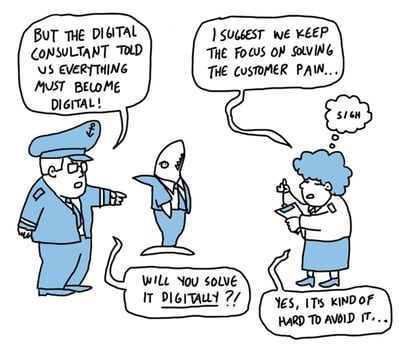Think digital transformation, the go-to phrase in recent years, is a new development? Think again. Properly speaking, digitisation began when the first computers were switched on in businesses; machines like UNIVAC 1, Leo and perhaps even Colossus (they really gave those early room-sized devices cool names).
1. Digital transformation is not new
This brings us to the first harsh truth of digital transformation: it’s nothing new. Sure, things took a big step forward when the personal computer was introduced in 1975 and then again when the internet came along in the early 1990s. But digitisation of business processes has been a, well, process on a continuum which stretches all the way back to the late 1940s.
The bottom line here is that digital transformation is just a fancy name for how technology is applied in the workplace to drive efficiency and performance. It doesn’t matter if that computing technology itself has a fancy name (or acronym) like AI, VR or IOT. The tools and techniques are all about doing business better.
2. Digital transformation is a journey, not a destination
One of the harsh peculiarities of the tech industry is that you’re only on the latest greatest for a couple of months before something better comes out. Cloud computing and the introduction of constant updates (which you’ll notice on your iPhone, Android and Windows 10 devices, as well as on Office 365) have mitigated this issue where software is concerned.
But hardware, once purchased, starts the inevitable march to obsolescence the minute it is installed. UNIVAC 1 may have started operating in 1951, but by 1968 it was really, really old news (note that tech in those days did have much longer life expectancy than it does today!)
Which makes the point that your digital transformation initiatives must be an ongoing effort. Keeping on top of it all requires vigilance. Not only do you need to keep track of what your competitors are doing, but it’s a good idea to know what technologies are available which can benefit your company (hint: a dependable IT partner can be invaluable in this respect).
It’s a good idea to establish, maintain and regularly revisit a technology roadmap. Given the rate of change, it goes without saying that your roadmap shouldn’t be inscribed on a stone tablet.

3. Being bold is risky
It’s tempting to imagine that being on the bleeding edge of digital transformation will deliver an automatic advantage. Sure, it might do so. It probably will. But being a first mover comes with risks, particularly when installing brand new technology. Even worse is the ‘technology trap’ of installing a new solution when there isn’t (yet) a problem for it to solve.
It’s standard practice for new technology to enjoy a big dollop of hype. Market analyst Gartner, Inc, calls it the ‘hype cycle’ and keeping an eye on the cycle can be an essential tool to help decide the right point at which to consider implementing new technology. Stay away from the ‘Peak of Inflated Expectations’. Instead look to jump in when the technology reaches the ‘Plateau of Productivity’. And, of course, keep on top of things with regular interactions with your IT partner.
4. If it isn’t brand new, it isn’t innovation
Along with ‘digital transformation’, the notion of innovation has similarly enjoyed massive hype in recent times. Think back to old television or radio adverts which promised you ‘new and improved’. Sadly, that’s a contradiction. If it is new, then it can’t be improved, because if it has been improved, then it isn’t new.
It’s the same with digital transformation. Just because you are digitising a process – say, an HR leave application which was once done on paper, but is now done electronically – that doesn’t mean you are innovating. Innovation literally means ‘something new’.
One of the risks when digitising formerly manual or paper-driven processes, is that you could be merely making a poorly executed process a little faster. If it is innovation you seek, examine the process carefully and look for how it can not only be done faster, but differently. Get that right and lay claim to ‘innovation’.

5. Don’t overdo it
With all the attention being focused on digital transformation, there is a sense that everything must change, and fast, or you’ll get left behind.
Don’t fall into this trap. Kiwis are pretty well known for their ‘if it ain’t broke don’t fix it’ approach (to the extent that it can become a problem – see #2 above). While this does need to be balanced against the necessity to stay current, it also helps maintain a healthy level of scepticism for proposed technology initiatives.
This is to be encouraged, because if you get caught up in the hype of digital transformation, there is the risk of taking on too much, too soon. Interrupting the flow of business to focus on widespread tech overhauls is never a good idea; change has to be managed and any transitions into digital ways of doing things, will come with an attendant overhead.
Does this mean digital transformation is a flash in the pan? Far from it. It has deep historical roots and the inexorable change which comes with technology development means it is something every company has to have an eye on. It was the past and it is the future.
To give your digital transformation plans a boost, get in touch with our consultants. We’ll be happy to assist.






